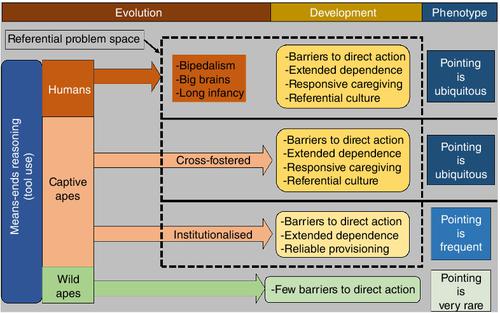当前位置:
X-MOL 学术
›
WIREs Cogn. Sci.
›
论文详情
Our official English website, www.x-mol.net, welcomes your
feedback! (Note: you will need to create a separate account there.)
The Referential Problem Space revisited: An ecological hypothesis of the evolutionary and developmental origins of pointing
WIREs Cognitive Science ( IF 3.2 ) Pub Date : 2021-01-28 , DOI: 10.1002/wcs.1554 David A Leavens 1
WIREs Cognitive Science ( IF 3.2 ) Pub Date : 2021-01-28 , DOI: 10.1002/wcs.1554 David A Leavens 1
Affiliation

|
Pointing by great apes poses a significant challenge to contemporary theories about the evolutionary and developmental foundations of cognitive development, because pointing has long been viewed by theoreticians as an evolved, human-unique developmental stepping-stone to linguistic reference. Although reports of pointing by great apes have existed in the scientific literature for over a century, only in recent decades has it become clear that ape pointing is definitely an intentionally communicative signal, by the same criteria we adjudge human pointing to be intentionally communicative. Theoretical responses to this changed empirical landscape have generally taken the approach of asserting, without any direct evidence (indeed, in the absence of any possibility of direct evidence), that pointing by humans is psychologically distinct from and more cognitively complex than the pointing of apes. It is commonplace in the contemporary literature to appeal to imaginary, species-unique causal factors to account for human pointing, rendering a large body of contemporary theoretical work untestable with scientific methods: scientific arguments require the public availability of core theoretical entities. In this paper, I will analyze the circumstances of pointing by apes and humans and develop an alternative theoretical model of pointing that does not rely upon non-physical constructs. According to the view espoused, here, pointing develops as a solution to a particular kind of developmental problem, characterized by (a) a developing capacity for tool use, (b) barriers to direct action, and (c) a history of caregiver responsiveness. Pointing by both apes and humans is explicable without invoking imaginary, mental causes.
中文翻译:

重新审视参考问题空间:指向进化和发展起源的生态假设
类人猿的指向对关于认知发展的进化和发展基础的当代理论提出了重大挑战,因为长期以来,理论家一直将指向视为语言参考的进化的、人类独特的发展垫脚石。尽管关于类人猿指向的报道在科学文献中已经存在了一个多世纪,但直到最近几十年才清楚地表明猿指向绝对是一种有意的交流信号,根据我们判断人类指向是有意交流的相同标准。对这种变化的经验景观的理论反应通常采取断言的方法,没有任何直接证据(实际上,在没有任何可能性的情况下)直接证据),人类的指向在心理上与猿类指向不同,并且在认知上更复杂。在当代文学中,诉诸虚构的、物种独特的因果因素来解释人类指向是司空见惯的,这使得大量当代理论工作无法用科学方法进行检验:科学论证需要核心理论实体的公开可用性。在本文中,我将分析猿和人类指向的情况,并开发一种不依赖于非物理结构的替代指向理论模型。根据所支持的观点,在这里,指向发展为解决特定类型的发展问题的方法,其特征在于(a)工具使用的发展能力,(b)直接行动的障碍,(c) 照顾者反应的历史。猿类和人类的指向都可以在不援引想象的心理原因的情况下进行解释。
更新日期:2021-01-28
中文翻译:

重新审视参考问题空间:指向进化和发展起源的生态假设
类人猿的指向对关于认知发展的进化和发展基础的当代理论提出了重大挑战,因为长期以来,理论家一直将指向视为语言参考的进化的、人类独特的发展垫脚石。尽管关于类人猿指向的报道在科学文献中已经存在了一个多世纪,但直到最近几十年才清楚地表明猿指向绝对是一种有意的交流信号,根据我们判断人类指向是有意交流的相同标准。对这种变化的经验景观的理论反应通常采取断言的方法,没有任何直接证据(实际上,在没有任何可能性的情况下)直接证据),人类的指向在心理上与猿类指向不同,并且在认知上更复杂。在当代文学中,诉诸虚构的、物种独特的因果因素来解释人类指向是司空见惯的,这使得大量当代理论工作无法用科学方法进行检验:科学论证需要核心理论实体的公开可用性。在本文中,我将分析猿和人类指向的情况,并开发一种不依赖于非物理结构的替代指向理论模型。根据所支持的观点,在这里,指向发展为解决特定类型的发展问题的方法,其特征在于(a)工具使用的发展能力,(b)直接行动的障碍,(c) 照顾者反应的历史。猿类和人类的指向都可以在不援引想象的心理原因的情况下进行解释。











































 京公网安备 11010802027423号
京公网安备 11010802027423号